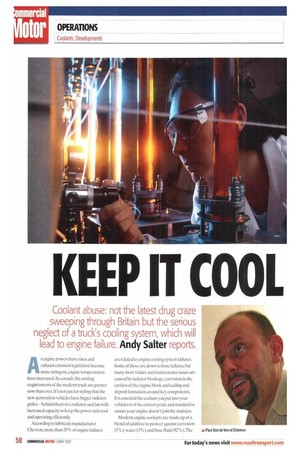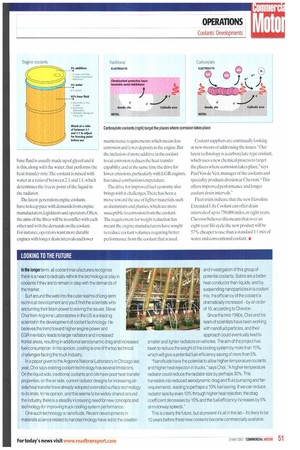KEEP IT COOL
Page 50

Page 51

If you've noticed an error in this article please click here to report it so we can fix it.
Coolant abuse: not the latest drug craze sweeping through Britain but the serious neglect of a truck's cooling system, which will lead to engine failure. Andy Salter reports.
As engine powers have risen and exhaust emission legislation become more stringent,engine temperatures have increased. As a result, the cooling requirements of the modem truck are greater now than ever. It's not just for styling that the new-generation vehicles have bigger radiator grilles —behind them sit a radiator and fan with increased capacity to keep the power unit cool and operating efficiently.
According to lubricant manufacturer Chevron, more than 20% of engine failures are related to engine cooling system failures. Some of those are down to hose failures, but many more failure and maintenance issues are caused by radiator blockage, corrosion in the cavities of the engine block and scaling and deposit formation around key components. It is essential the coolant you put into your vehicles is of the correct grade and standard to ensure your engine doesn't join the statistics.
Modern engine coolants are made up of a blend of additive to protect against corrosion (5%). water (3%) and base fluid (92% ).The base fluid is usually made up of glycol and it is this, along with the water, that performs the heat transfer role.`lbe coolant is mixed with water at a ratio of between 2:1 and 1:1. which determines the freeze point of the liquid in the radiator.
The latest-generation engine coolants have to keep pace with demands from engine manufacturers, legislators and operators. Often. the aims of the three will be in conflict with each other and with the demands on the coolant. For instance, operators want more durable engines with longer drain intervals and lower maintenance requirements, which means less corrosion and fewer deposits in the engine. But the inclusion of more additive in the coolant to cut corrosion reduces the heat transfer capability, and at the same time the drive for lower emissions, particularly with EGR engines, has raised combustion temperature.
The drive for improved fuel economy also brings with it challenges.There has been a move toward the use of lighter materials.such as aluminium and plastics, which are more susceptible to corrosion from the coolant. The requirement for weight reduction has meant the engine manufacturers have sought to reduce coolant volumes, requiring better performance from the coolant that is used. Coolant suppliers are continually looking at new means of addressing the issues. "Our latest technology is a carboxylate-type coolant, which uses a new chemical process to target the places where corrosion takes place," says Paul Van de Ven, manager of the coolants and speciality products division at Chevron."Ibis offers improved performance and longer coolant drain intervals."
Fleet trials indicate that the new Havoline Extended Life Coolant can offer drain intervals of up to 750,000 miles, or eight years. Chevron believes this means that over an eight-year life cycle the new product will be 57% cheaper to use than a standard 1:1 mix of water and conventional coolant. •


























































































































































































